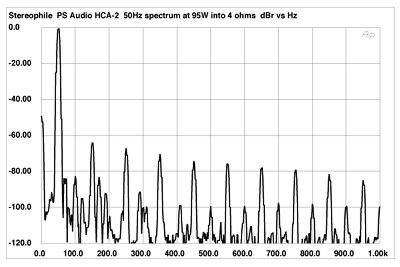| Columns Retired Columns & Blogs |
PS Audio HCA-2 power amplifier Measurements part 2
Because this measurement also includes the contribution of noise, I again wondered if the graph was being affected by ultrasonic noise. However, monitoring the distortion content on an oscilloscope screen indicated that the rise in distortion at high frequencies is indeed due to nonlinear behavior. This is shown in figs.6 and 7. Fig.6 was taken at 1W into 8 ohms. The measured THD+noise level was 0.16%, and the distortion content can be seen to be almost pure third harmonic. However, if the load is halved to 4 ohms and the power increased a little, the third harmonic is joined by higher odd-order spuriae to give the waveform shown in fig.7. True, the distortion level is still fairly low at 0.33%, but the presence of the higher harmonics will audibly affect the signal.
Footnote 1: Subsequent to the publication of the review, I wondered if what the measurements were showing was actually slew-rate limiting. This would tie in with both the increase in measured THD with increasing frequency and with increasing output voltage. The slew-rate limiting would result from the amplifier's output-stage switching frequency reaching its limit and therefore not being able to meet the demands of the signal.—John Atkinson

Fig.6 PS Audio HCA-2, 1kHz waveform at 1W into 8 ohms (top), distortion and noise waveform with fundamental notched out (bottom, not to scale).

Fig.7 PS Audio HCA-2, 1kHz waveform at 9.5W into 4 ohms (top), distortion and noise waveform with fundamental notched out (bottom, not to scale).
This harmonic content is shown in a different way in figs.8 and 9, the spectrum of the amplifier's output while it reproduces 50Hz and 1kHz sinewaves at fairly high powers into 4 ohms. Again, the higher-order harmonics will be audible. Note that the 120Hz AC supply component in fig.8 lies at almost -100dB, implying good grounding in my test setup. However, when I examined the amplifier's reproduction of the admittedly demanding 1:1 mix of 19kHz and 20kHz tones (fig.10), not only were there many 1kHz-spaced intermodulation products present, but the two fundamental tones were surrounded by sidebands spaced at multiples of 120Hz, which suggests that at high powers the HCA-2's power supply is not up to the task demanded of it.

Fig.8 PS Audio HCA-2, spectrum of 50Hz sinewave, DC-1kHz, at 95W into 4 ohms (linear frequency scale).

Fig.9 PS Audio HCA-2, spectrum of 1kHz sinewave, DC-20kHz, at 100W into 4 ohms (linear frequency scale).

Fig.10 PS Audio HCA-2, HF intermodulation spectrum, DC-24kHz, 19+20kHz at 25W into 8 ohms (linear frequency scale).
This graph was taken at an indicated 25W into 8 ohms (due to the nature of the twin-tone waveform, the actual power will be twice this), which is well below both the amplifier's specified power into 8 ohms and the level at which clipping of the waveform could be seen on the oscilloscope screen. Yet the amplifier's poor high-frequency linearity results in 18kHz and 21kHz intermodulation products present at -54dB (0.2%). The 1kHz difference product lies at a more respectable -74dB (0.02%), however.
There was some good news: With a continuous 1kHz tone, the HCA-2 managed to exceed its specified output power, with 170W available into 8 ohms (22.3dBW) at the usual 1% THD clipping point, and 260W into 4 ohms (21.1dBW). As shown by the top trace in fig.11, however, the amplifier turned off at 375W into 2 ohms, its red Fault indicator lighting up. Because the PS Audio's output stage is balanced, I wasn't able to test its dynamic output power capabilities because the PC card used as the platform for the Miller test sofware needs to reference the signal to ground.

Fig.11 PS Audio HCA-2, distortion (%) vs output power into 100k (from bottom to top at 10W): 16 ohms, 8 ohms, 4 ohms, 2 ohms.
I was disappointed with the PS Audio HCA-2's measured performance, particularly regarding its lack of high-frequency linearity. This behavior suggests that the amplifier circuit has limited open-loop bandwidth, which conventional engineering practice suggest could be coped with by applying more loop negative feedback. The resultant improvement in high-frequency linearity would be achieved at the expense of overall voltage gain; as the HCA-2 has around 6dB more gain than is strictly necessary, it might be thought that applying the same 6dB of loop feedback would radically improve the amplifier's measured performance (footnote 1).
However, it is not my job to second-guess designers. As PS Audio's Paul McGowan is one of the more careful listeners around, he presumably decided that increasing the amount of negative feedback to improve the measurements did not make the sound better, and perhaps made it worse. But I'd certainly expect the HCA-2's measured problems to have audible consequences. Perhaps it was the presence of added high-frequency harmonic content that gave Kal Rubinson the impression that the HCA-2 pushed the soundstage forward, though he didn't find its presentation "glaring." Certainly more auditioning is called for if we are to confirm the HCA-2's Class A rating in "Recommended Components."—John Atkinson
Footnote 1: Subsequent to the publication of the review, I wondered if what the measurements were showing was actually slew-rate limiting. This would tie in with both the increase in measured THD with increasing frequency and with increasing output voltage. The slew-rate limiting would result from the amplifier's output-stage switching frequency reaching its limit and therefore not being able to meet the demands of the signal.—John Atkinson
- Log in or register to post comments




































